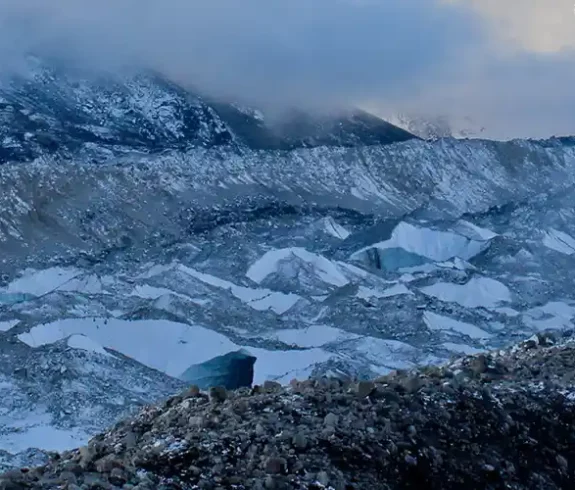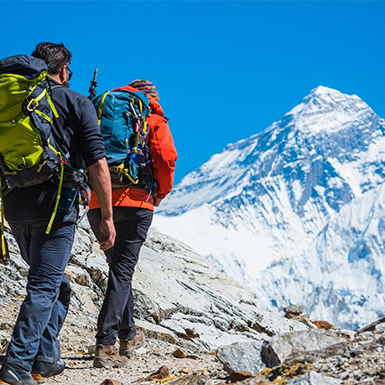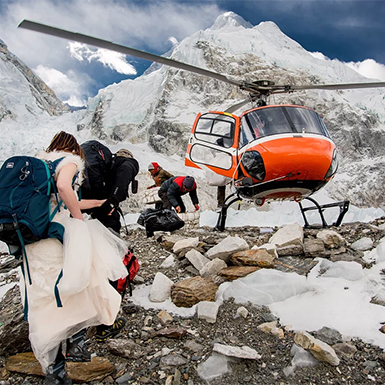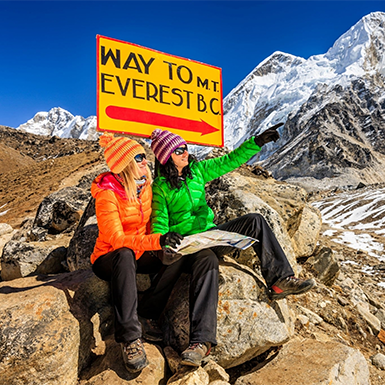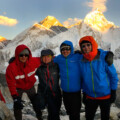Nestled in the heart of the Everest region, the Khumbu Glacier isn’t simply a picturesque marvel. It forms an essential part of the mountaineering trek, presenting both an awe-inspiring vista and a daunting challenge for those with Everest ambitions. To reach their goal, climbers must navigate its treacherous terrain, which includes the notorious Khumbu Icefall.
Beyond its significance in mountaineering, this glacier holds immense value for the scientific community. It is a living laboratory, offering a unique window into glacier formation and movement processes. Researchers are keenly observing the glaciers to understand the effects of climate change on these delicate ecosystems.
Formation and Importance of the Khumbu Glacier
Gaining insights into the glacier’s formation and its relevance to the field of glaciology enhances our understanding of its role in the Everest Region.
- Snow Accumulation and Compaction: The glacier’s story began with the gradual accumulation of snow over countless years. In the high-altitude environment of the Himalayas, where sub-zero temperatures prevail for most of the year, snowfall doesn’t melt. Instead, it undergoes a slow compaction process under its weight, transforming into dense ice.
- Glacial Flow and Landscape Shaping: As more snow accumulates and compresses, the immense pressure forces the ice to move downhill, carving out valleys, creating moraines, and molding the dramatic landscape we admire today. This Glacier movement showcases the powerful forces in this region.
- Climate Change Indicator: Glaciers are highly sensitive to climate change, and the Khumbu Glacier is no different. Scientists meticulously track its size, flow rate, and overall health changes to evaluate rising temperatures’ impact on the Himalayan environment. Data gathered from this glacier contribute to our understanding of global climate patterns and their potential consequences.
- Water Resource and Ecosystem Support: The Khumbu Glacier is a vital water source that feeds rivers and streams and supports downstream communities. It also sustains a unique ecosystem adapted to harsh, high-altitude conditions. Glacier research provides essential data to comprehend the intricate workings of this environment and predict the impact of future changes.

Discovering the Khumbu Glacier: Your Trekking Companion
The Khumbu Glacier location, a majestic landmark in the Everest region, offers more than just a visual spectacle; it serves as a core component of the trekking adventure for those drawn to the world’s tallest peak. Understanding where and how to reach it is essential when planning a trip to this awe-inspiring region.
Pinpointing the Khumbu Glacier
Situated in the heart of Nepal’s Khumbu region, the glacier meanders down the Himalayan slopes, forging a path through the rugged terrain. It rests on Mount Everest’s southern flank, making it a prominent feature for climbers and trekkers.
Near the glacier is the renowned Everest Base Camp, where countless expeditions have commenced their trips to the summit of Mount Everest. The glacier lies just beyond, marking the start of the demanding climb toward the peak. A map of the area can visually depict its location relative to other significant points in the region.
Reaching the Khumbu Glacier: Trekking Options
While casual visitors can’t directly access this Glacier, several popular trekking routes offer stunning views and the chance to experience its magnificence up close.
- Everest Base Camp Trek: This classic trek remains the most popular choice for witnessing the glacier firsthand. The trail winds through charming Sherpa villages, verdant forests, and over suspension bridges, culminating in a breathtaking view of the glacier and surrounding peaks from Everest Base Camp.
- Gokyo Lakes Trek presents a different perspective on the Khumbu region. It leads to the pristine Gokyo Lakes and Gokyo Ri, a vantage point offering sweeping panoramas of the Everest massif, including the Khumbu Glacier.
- Everest Three Passes Trek: Designed for seasoned trekkers seeking a challenge, this trek crosses three high mountain passes, granting unparalleled views of this Glacier and its neighboring peaks.
Essential Considerations for Reaching the Khumbu Glacier
- Permits: Trekkers must secure permits to enter the Everest region, including Sagarmatha National Park, home to the glacier.
- Altitude Acclimatization: The Khumbu region’s high altitude necessitates proper acclimatization to prevent altitude sickness. Gradual trekking allows your body to adjust to the thinner air.
- Physical Fitness: Trekking in this region requires good physical condition. Be prepared for long days of hiking on challenging terrain.
- Guided Treks: Consider a guided trek, especially if you’re new to the region or high-altitude trekking. Experienced guides offer invaluable support and ensure your safety.
Key Information for Trekkers
- The Khumbu Glacier is the world’s highest, reaching elevations surpassing 7,600 meters (24,900 feet).
- It’s a perpetually moving river of ice, flowing at a rate of several hundred meters annually.
- The Khumbu Icefall, a section of the glacier near Everest Base Camp, is renowned for its treacherous terrain and ever-shifting ice formations.
- The glacier plays a crucial role in the local ecosystem, providing water to communities downstream and supporting diverse flora and fauna.
Exploring the Khumbu Glacier: A Majestic Icy Behemoth
The Khumbu Glacier, a colossal river of ice nestled among the towering peaks of the Everest region, commands attention with its immense size and ever-shifting nature. Let’s trek deeper into its geographical expanse, captivating features, and the transformative force it exerts on the surrounding landscape.
Dimensions that Dwarf the Imagination
- Size and Length: The Khumbu Glacier stretches an impressive 12 kilometers (7.5 miles), winding its way from the foot of Everest towards the Khumbu Icefall Everest, showcasing its vast expanse.
- Altitude: As the planet’s highest glacier, the Khumbu Glacier reaches extraordinary altitudes. Its terminus, which converges with the Khumbu Icefall, sits approximately 5,000 meters (16,400 feet). From there, it steadily climbs, reaching elevations exceeding 7,600 meters (24,900 feet) near its source.
The Khumbu Icefall: A Perilous Marvel
- Significance: The Khumbu Icefall Everest, a dynamic and perpetually changing section of the glacier, marks a critical point on the path to the summit. Climbers face a formidable challenge navigating its labyrinth of towering ice pinnacles, deep crevasses, and unstable ice formations.
- Formation: This icy spectacle forms as the Khumbu Glacier descends a steep slope, causing the ice to fracture and shatter into a chaotic jumble. The glacier’s constant movement ensures the icefall remains in a perpetual flux, with new crevasses and seracs continually emerging.
Nature’s Sculptor: Glacial Movement and Landscape Transformation
- Glacial Flow: Like its icy counterparts, this Glacier is in constant motion. Gravity and the immense pressure of its weight propel the ice to flow slowly downhill at a rate of several hundred meters annually.
- Shaping the Landscape: The glacier’s relentless movement carves and molds the surrounding terrain, leaving an enduring mark on the landscape. Its advance and retreat create valleys, moraines, and other distinctive glacial landforms.
- Impact on the Icefall: The movement of this Glacier directly influences the ever-changing nature of the Khumbu Icefall. As the glacier flows, it carries massive blocks of ice towards the icefall, contributing to its constant evolution and creating new challenges for climbers.
Experiencing the Khumbu Glacier
- Mapping the Glacier: A detailed map is crucial for understanding the glacier’s layout and navigating its demanding terrain. It highlights key features such as the Khumbu Icefall, Base Camp, and well-trodden trekking routes.
- Trekking Routes: Several trekking routes grant access to this Glacier, offering firsthand encounters with its grandeur. The most popular choice, the Everest Base Camp trek, culminates in a panorama of glacial splendor and majestic mountains.
- Safety First: Venturing onto the Khumbu Glacier demands meticulous preparation and respect for its inherent dangers. Awareness of the risks associated with crevasses, avalanches, and altitude sickness is paramount. Hiring a seasoned guide is strongly recommended for a safe and enjoyable exploration.

The Khumbu Glacier: A Living Tapestry of History and Culture
The Khumbu Glacier, a majestic expanse of ice in the Everest region, isn’t just a geographical marvel. It is deeply interwoven with the history of Everest expeditions and holds profound cultural significance for the local Sherpa community. Let’s explore the glacier’s rich tapestry of stories, from early exploration to its enduring place in Sherpa culture.
Khumbu Glacier and Everest Expeditions: A Shared History
- Early Exploration: The Khumbu Glacier first captured the world’s attention in the early 20th century when mountaineering pioneers set their sights on Everest. It became an integral part of the route to the summit, presenting both a challenge and a source of awe for those daring to venture into its icy embrace.
- The First Ascents: The Khumbu Icefall Everest, a treacherous section of the glacier, played a pivotal role in the historic first ascents of Everest in 1953. Sir Edmund Hillary, Tenzing Norgay, and their brave companions surmounted this daunting obstacle, leaving an indelible mark on the annals of mountaineering.
- Evolution of Climbing Routes: Over the years, climbers have adapted their strategies and techniques for tackling this Glacier. Constant vigilance and adaptation are necessary to navigate the ever-changing icefall, and climbers continuously pioneer new routes and approaches to ensure safe passage.
The Khumbu Glacier in Sherpa Culture: A Sacred Landscape
- Spiritual Significance: The Khumbu Glacier is more than just a natural phenomenon for the Sherpa people. It’s a sacred landscape, imbued with spiritual meaning and deeply connected to their cultural identity.
- Guardian Deities: The Sherpas believe that the mountains and glaciers are home to mighty deities, including those residing within the Khumbu Glacier. These deities are revered and respected, with offerings and prayers made to ensure safe passage and good fortune.
- Harmony with Nature: Sherpa culture emphasizes living in harmony with the natural world. As a vital part of their environment, this Glacier is treated with reverence and care, reflecting their deep connection to the land.
The Khumbu Glacier Today: A Living Legacy
- A Constant Reminder: The Khumbu Glacier serves as a constant reminder of the challenges and triumphs experienced by those who have ventured into its icy domain. It is a powerful reminder of the human spirit’s capacity to overcome challenges and the unwavering fascination with Everest.
- A Source of Inspiration: The glacier’s beauty and power inspire awe and wonder in all who witness it. It reminds us of nature’s delicate balance and the importance of preserving these fragile ecosystems.
- A Cultural Touchstone: For the Sherpa community, this Glacier remains a cultural touchstone, connecting them to their ancestors and their rich heritage. It represents a legacy that will continue to shape their identity and way of life for generations.

Changing Landscape in the Face of Climate Change
High in the Himalayas, the majestic Khumbu Glacier starkly reminds us of the impact of climate change on delicate ecosystems. Rising global temperatures are causing significant changes to this vital part of the Everest region, raising concerns about the future of the local environment and its inhabitants.
Climate Change and the Khumbu Glacier: A Warming Reality
Like many others worldwide, this Glacier is experiencing the effects of a warming planet. Higher temperatures accelerate melting, causing the glacier to recede alarmingly. These changes have visibly transformed the landscape, forming new glacial lakes, altering river flow, and increasing the risk of glacial lake outburst floods.
The Ripple Effects of Glacial Melt
The melting of the Khumbu Glacier carries far-reaching consequences for the entire region.
- Water Scarcity: The glacier is a critical water source, feeding rivers and streams that sustain communities downstream. Reduced glacial melt could lead to water shortages, impacting agriculture, drinking water supplies, and even hydropower generation.
- Natural Disaster Risks: Glacier melting has the potential to create large glacial lakes susceptible to sudden outbursts, leading to devastating floods in downstream areas. These events significantly threaten human lives and livelihoods, potentially destroying villages, infrastructure, and agricultural land.
- Ecosystem Disruption: The Khumbu Glacier supports a unique high-altitude ecosystem. The glacier’s decline could disrupt the delicate ecological balance, endangering plant and animal life and negatively impacting the livelihoods of local people who rely on these resources.
Scientific Evidence of Change
Numerous scientific studies have documented the Khumbu Glacier’s retreat and its potential consequences. Researchers employ a combination of field observations, remote sensing data, and computer modeling to track changes in the glacier’s size, mass balance, and flow rate.
- Accelerated Retreat: Studies reveal that this Glacier has been receding at an accelerating rate in recent decades, with estimates suggesting a significant loss of ice mass over the past 50 years.
- Glacial Lake Formation: The glacier’s melting has triggered the formation and expansion of several glacial lakes in the region. These lakes risk outburst floods, highlighting the need for vigilant monitoring and mitigation measures.
- Impact on Water Resources: Research suggests that alterations in glacial meltwater could significantly impact water resources in the region, particularly during the arid months when river flows are heavily dependent on glacial runoff.
The Path Forward: Adapting and Mitigating
Addressing the challenges of climate change in the Khumbu region demands a multifaceted approach.
- Monitoring and Research: Continuous scientific monitoring and research are crucial to understanding the glacier’s ongoing changes and developing effective adaptation and mitigation strategies.
- Community Resilience: Empowering local communities to adapt to the changing environment is essential. Efforts aim to promote sustainable resource use, establish early warning systems for potential glacial lake outbursts, and create alternative income sources for local communities.
- Global Action on Climate Change: Safeguarding the Khumbu Glacier and its icy counterparts worldwide hinges on collaborative global action to reduce greenhouse gas emissions and mitigate the effects of climate change.

Khumbu Glacier: A Thriving Ecosystem at the Roof of the World
The Khumbu Glacier, a majestic river of ice winding through the heart of the Everest region, offers more than just a breathtaking spectacle of frozen beauty. It sustains a unique and delicate ecosystem, teeming with life adapted to the demanding high-altitude environment. Explore the captivating wildlife and intricate ecosystem flourishing amidst this icy landscape.
A High-Altitude Haven for Life
The Khumbu Glacier and its surrounding areas create diverse habitats, from the glacier’s icy surface to the rocky moraines and alpine meadows at its edges. This variation in terrain and microclimates allows a surprising array of plant and animal life to thrive, each uniquely equipped to survive in this challenging environment.
Flora and Fauna of the Khumbu: A Tapestry of Life
Despite the harsh conditions, various plants and animals call the Khumbu region home. Here’s a glimpse of some of the remarkable species you might encounter:
Plants
- Lichens and Mosses: These hardy pioneers often take the first steps in colonizing bare rock, paving the way for other plant life.
- Alpine Flowers: Colorful wildflowers like saxifrages, gentians, and primroses paint the landscape with vibrant hues during the warmer months.
- Juniper and Rhododendron: These shrubs and trees, found at lower elevations, provide crucial shelter and sustenance for wildlife.
Animals
- Himalayan Tahr: These nimble mountain goats expertly navigate the steep slopes and rocky terrain.
- Musk Deer: These shy creatures are renowned for their musk glands, producing a valuable perfume scent.
- Snow Leopard: This elusive predator reigns supreme as the apex predator of the high Himalayas, its coat providing perfect camouflage in the snowy landscape.
- Birds: The Khumbu region boasts a diverse avian population, including Nepal’s iconic Himalayan Monal and the magnificent Lammergeier, renowned for its extraordinary wingspan of up to 3 meters.
Survival in the Extreme: Adaptations to the Harsh Environment
Thriving in the Khumbu Glacier region demands remarkable adaptations. Wildlife has evolved ingenious ways to cope with these challenging conditions:
- Thick Fur and Feathers: Many animals sport thick fur or feathers to insulate them against biting cold temperatures.
- Large Lungs and Efficient Oxygen Transport: The thin air at high altitudes poses a breathing challenge. To overcome this obstacle, animals like the Himalayan Tahr have developed large lungs and efficient oxygen transport systems.
- Hibernation and Migration: Some animals hibernate during the harsh winter months, while others migrate to lower elevations where conditions are more hospitable.
- Camouflage: Many animals possess coloration that helps them seamlessly blend into their surroundings, offering protection from predators.
Witnessing the Wildlife: Exploring the Khumbu Glacier
Trekking: The best way to experience the Khumbu Glacier’s wildlife is to trek through the region. Trekking routes such as Everest Base Camp and Gokyo Lakes provide abundant opportunities to encounter various plants and animals.
Wildlife Viewing Tips:
- Patience and Observation: Wildlife can be elusive, so patience and keen observation are key.
- Binoculars: Binoculars enable you to spot animals from afar and look closely at their behavior.
- Respect for Wildlife: Respect wildlife by maintaining a safe distance and avoiding disruptions to their natural environment.
Trekking and Thrills: Exploring the Khumbu Glacier
While mountaineers focus on conquering Everest, the Khumbu Glacier offers a captivating playground for trekkers and adventurers. Its unique blend of scenic beauty and physical challenge creates an unforgettable Himalayan experience. Let’s uncover the trekking routes that lead to this icy giant, share essential tips, and unveil the exhilarating adventure opportunities it presents.
Trekking Routes: Witnessing the Majesty of the Khumbu
Several well-trodden trekking routes guide you to the awe-inspiring Khumbu Glacier:
- Everest Base Camp Trek: This iconic trek remains a favorite for experiencing the glacier up close. The trail meanders through charming Sherpa villages, vibrant rhododendron forests, and exhilarating suspension bridges. It culminates in a breathtaking panorama of the glacier and surrounding peaks from Everest Base Camp.
- Gokyo Lakes Trek: This trek offers a unique vantage point of the region, leading to the pristine Gokyo Lakes and Gokyo Ri. From here, trekkers can enjoy sweeping vistas of the Everest massif, including the Khumbu Glacier and the formidable Khumbu Icefall.
- Everest Three Passes Trek: This route crosses three high mountain passes, Renjo La, Cho La, and Kongma La, and is a challenge best suited for experienced trekkers. It promises unparalleled views of the Khumbu Glacier and surrounding peaks but demands excellent physical fitness and proper acclimatization.
Trekking Tips: Preparing for the Khumbu Adventure
Best Time to Visit: The prime trekking seasons are spring (March-May) and autumn (September-November), offering clear skies and stable weather.
Essential Gear: Pack warm layers, waterproof clothing, sturdy hiking boots, sunglasses, sunscreen, a hat, and a comfortable sleeping bag.
Safety First
Acclimatize gradually to avoid altitude sickness.
- Consider hiring a knowledgeable guide, especially if you’re new to high-altitude trekking or the region.
- Be aware of the dangers of glacier trekking, including crevasses and rapidly changing weather conditions.
Mastering the Khumbu Glacier: Your Guide to Safe Exploration
The Khumbu Glacier, a breathtaking expanse of ice and snow in the Himalayas, offers trekkers and climbers an unforgettable adventure. However, navigating this majestic landscape demands careful planning and adherence to safety protocols. This comprehensive guide presents a visual overview of the glacier, essential navigation tips, and crucial safety considerations for your trek.
Visualizing the Khumbu Glacier
Imagine a sprawling expanse of ice and snow winding its way down the slopes of Mount Everest – that’s the Khumbu Glacier. A Khumbu Glacier map offers trekkers a visual representation of the area’s vastness and highlights its critical landmarks.
- Everest Base Camp: The bustling hub for Everest expeditions, situated at the glacier’s foot.
- Khumbu Icefall: A treacherous section known for its constantly shifting ice formations and deep crevasses.
- Gorakshep: A high-altitude village offering stunning views of Everest and the glacier.
- Kala Patthar: A popular viewpoint for panoramic vistas of the Everest region, including the glacier.
Navigating the Terrain: A Trekker’s Guide
Trekking on the Khumbu Glacier poses unique challenges, but adequate preparation and guidance can be a safe and rewarding experience.
- Stay on the Trail: Adhere to well-marked trails to minimize the risk of encountering crevasses or unstable ice formations.
- Hire a Guide or Porter: Consider hiring an experienced guide or porter with local knowledge that can ensure your safety.
- Utilize Landmarks: Identify critical landmarks like the Khumbu Icefall, Base Camp, and prominent peaks to maintain your bearings and stay on course.
- Consult a Map: Carry a Khumbu Glacier map along with a compass or GPS device for navigation, especially in areas with limited visibility or challenging terrain.
- Monitor Weather Conditions: Mountain weather is highly variable. Check weather reports regularly and equip yourself for changing conditions.
Safety First: Respecting the Glacier’s Power
While breathtaking, the Khumbu Glacier presents inherent dangers that trekkers must acknowledge:
- Crevasses: Deep cracks in the ice, sometimes hidden by snow bridges, can pose a significant risk of falls. Exercise caution and avoid venturing off the established trails.
- Avalanches can occur in certain areas, especially during heavy snowfall or rapid temperature changes. Heed warnings from local authorities and steered clear of high-risk zones.
- Altitude Sickness: The high altitude of the Khumbu region can trigger altitude sickness. Acclimatize gradually by ascending slowly and maintaining hydration.
Essential Safety Tips for Trekking
- Trek in a Group: Trekking with others enhances safety and provides support in emergencies.
- Wear Appropriate Gear: Dress in layers, choose sturdy hiking boots and utilize trekking poles for stability.
- Carry Essential Supplies: Pack a first-aid kit, ample water, high-energy snacks, and a headlamp or flashlight.
- Share Your Plans: Inform someone about your trekking itinerary and expected return time.
The Khumbu Glacier: A Himalayan Icon Worth Protecting
Nestled in the heart of the Everest region, the majestic Khumbu Glacier offers an unparalleled experience for those seeking adventure and natural beauty. This icy giant captivates with its breathtaking scenery, challenging terrain, rich cultural significance, and vital role in the ecosystem.
An Unforgettable Destination
The Khumbu Glacier isn’t simply a point of interest for trekkers; it’s an iconic landmark symbolizing the spirit of adventure and the raw power of nature. Whether you’re an experienced climber aiming for Everest’s summit or a trekker eager to witness its grandeur, this Glacier has something special for everyone.
- Trekking: Explore the glacier’s surroundings through popular routes like the Everest Base Camp or the Gokyo Lakes trek, each offering unique views and experiences.
- Adventure: Thrill-seekers can test their skills on the challenging Khumbu Icefall, while the glacier provides an opportunity to witness its dynamic beauty up close.
- Cultural Immersion: Discover the rich Sherpa culture intertwined with the glacier, from its spiritual significance to the traditions of the local communities.
- Scientific Exploration: Explore the Khumbu Glacier’s geological formations to gain a deeper appreciation for its crucial role in the ecosystem and recognize the impacts of climate change on this fragile environment.
A Call for Responsible Exploration and Conservation
While we admire the Khumbu Glacier’s splendor, we must also acknowledge its vulnerability. Climate change and human-induced factors threaten the delicate balance of its ecosystem. It’s our collective duty to safeguard this natural wonder for future generations.
- Practice Responsible Trekking: Adhere to Leave No Trace principles, minimizing environmental impact. Pack out all trash, stay on designated trails, and respect local customs and wildlife.
- Support Conservation Efforts: Consider contributing to organizations that preserve the Khumbu region and its extraordinary biodiversity. Your support can play a crucial role in protecting this fragile ecosystem.
- Spread Awareness: Educate others about the Khumbu Glacier to foster appreciation and inspire conservation efforts.
